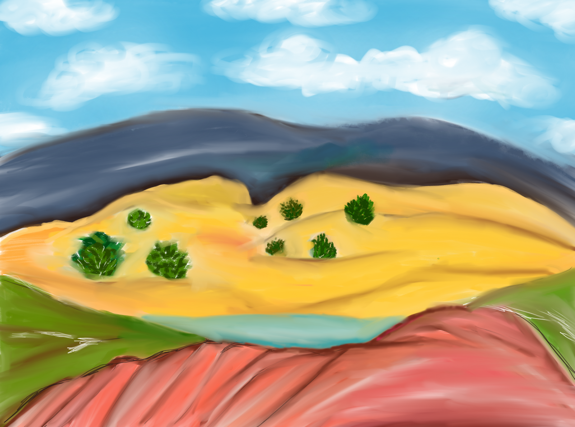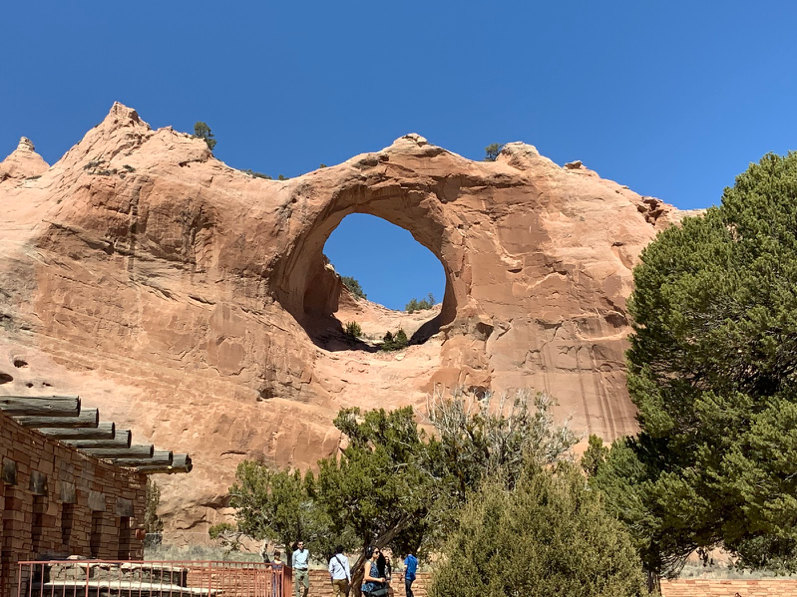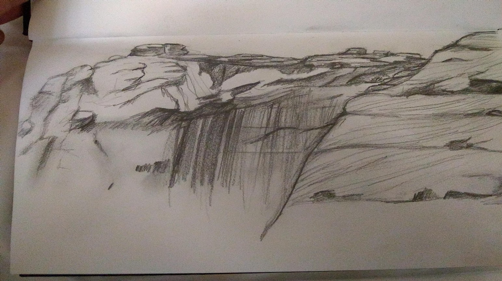09 May 2019 Location, location, location… finding place in a nation of four states
By Melody Wu, Mission 2022

The common questions to ask on road trips are often: “Where are we going? How much longer till we get there?” However, on the Terrascope Spring Break trip, I find myself staring in wonder at the environment that surrounds me as we drive across the Navajo Nation to each location, each with a million stories just like each changing moment as the wind blows across the red, brown, and orange landscapes. After our research this past fall semester talking with members of the Diné community about water security in the Navajo Nation, our Terrascope mission for this year, it was amazing to be here and really see and experience what we had been trying to understand miles away in Boston.
After leaving Canyon de Chelly with its beautiful colorful mesas Sunday night, we came to Window Rock, Arizona, the capital of the Navajo Nation. It was here that I really began to think about the importance of location. The Navajo Nation’s location has importance with respect to other states, has cultural and historical importance, and continues to have an impact on the location. Window Rock’s location as the capital holds meaning in the cultural and historical context of the Navajo Nation.

As MIT alum and Diné citizen Levon Thomas (MIT ‘09) told us, the reason why Window Rock was chosen as the capital of the Navajo Nation was because of its historical location as a place of congregation. The Diné would come to Window Rock to speak from it, and the echoes of the meeting could be heard throughout the area.
Staring at this great formation of the landscape, I began to imagine what Window Rock might have looked like before, what echoes might have surrounded these walls, and what it means to the Diné and their culture. Now at Window Rock sits the president’s office and several other buildings of the Navajo Nation government. Touring the office I saw a careful balance of culture and tradition blending with modern society.
Looking through the Navajo Nation Cultural Center and Museum and coming across one painting in particular about the Walk, I could really feel the history, the struggle, the tears, the pain, but also the triumph of the Diné upon returning to their land, Diné Bikeyah. The colors of Diné art and the kachina dolls speak of their stories and of connections to their land that can never be broken. This location at the Four Corners connects them to their culture and traditions.
The location of the Navajo Nation in the United States at the “Four Corners” (Arizona, New Mexico, Utah, and Colorado) continues to hold significance to the Diné and people on the reservation when it comes to water today. Not only does location matter depending on whether you live on the reservation, the nation also faces external factors that contribute to challenges to their water rights due to their location. In the Western Agency of the Navajo Nation, water supply is a central issue, while on the Eastern Agency water quality is a central issue. The Navajo Nation is at a location in which a lot of other states’ priorities often come beforehand, leading to complex negotiations. There is California, which takes up much of the water supply of the Lower Basin. And there are Phoenix and Tucson in Arizona which have the money and finances to back them and their policies. This puts the Navajo Nation at odds with representatives and the federal and surrounding state governments since their water security now lies upon these two groups and the surrounding states in order to make their own decisions and to find the right timing to make a move— even though most of the water flows through the Navajo Nation and is from the aquifers underneath it. However, this does not mean the Navajo Nation lacks influence. They were able to pass the Navajo Gallup Pipeline project and water rights by adding a section to the Omnibus Bill— and as a result, they are able to have control of their pipeline project and the distribution of its water to the rest of the Western Agency of the Navajo Nation.
Talking with Robert, a hydrologist of the Navajo Nation’s Water Department, gave me much of this insight into the complexity of water security but also about the other challenges that tie into it, including the social and cultural challenges. Although unemployment is prevalent, people qualified for jobs like lawyers, hydrologists, and others often find jobs just outside of the reservation because of the higher pay. Location continues to play a role on this as for many like Robert who live in other towns or cities with their families: the commute is often long — with at least an hour’s drive or more necessary in order to get to the capital and the other locations that Robert and many others like him need to get to work.
According to Robert, much of the unemployment is because of how much of the Navajo Nation is land for agriculture and many maintain their culture by living off the land and peacefully cultivating their land rather than looking for jobs or creating other forms of industry. And there is a certainly a great amount of admiration and respect I have for this— the beautiful mesas with their hidden Anasazi pueblos and cliff dwellings and the cultures and stories that come with their daily life are certainly worthy of a lifetime of protection and dedication to farming and way of life.
At this crossroads, there is both empowerment but also conflict. This feeling of balancing tradition and culture and modern society is a challenge many across the world face and many of the Diné people we have talked with recount. This feeling is in itself a kind of abstract location— a location that represents a state of feeling and being and contains our emotions and thoughts.
On this adventure, I hope to hear more of what they have to say about this feeling and am left with lots of questions about our adventure here in the Navajo Nation: How do we ensure we treat each other as equals when there are limited resources, when it conflicts with how we have been brought up in society, and when there are cultural clashes? What does having water mean— and even more specifically, how does having running water or hauling water and the right to water contribute to our sense of dignity? How has my location impacted my access to water as a Californian but now also as an MIT student in Boston? And finally, where will we go from here when we think about water and the role it plays in our everyday lives, our health, our growth, our culture, and our place in society?




